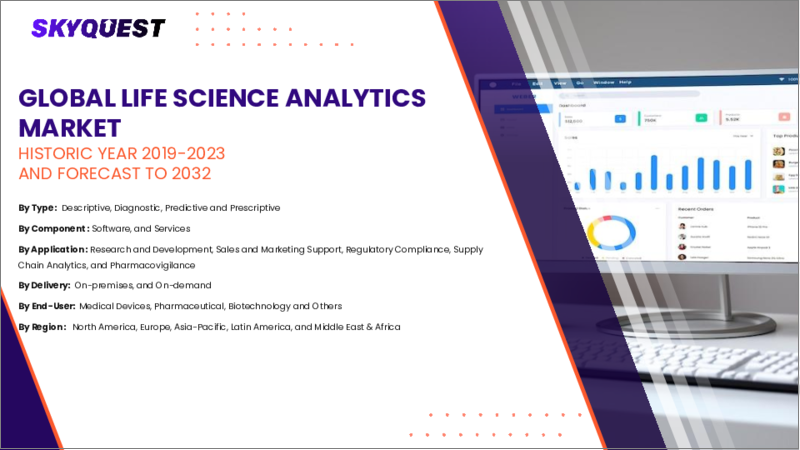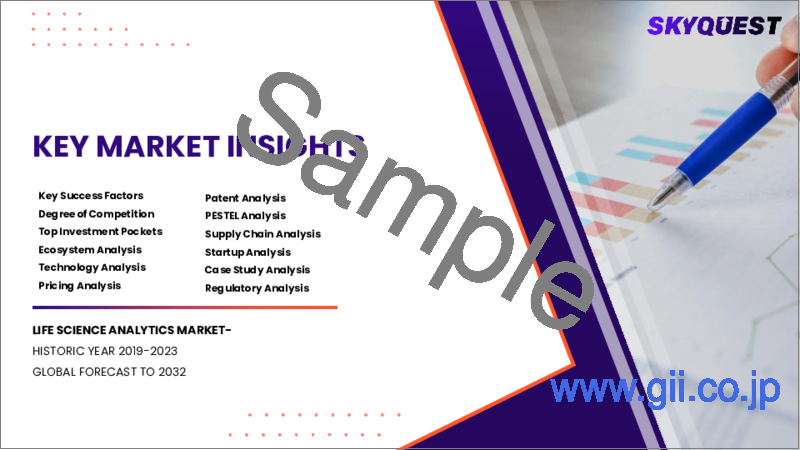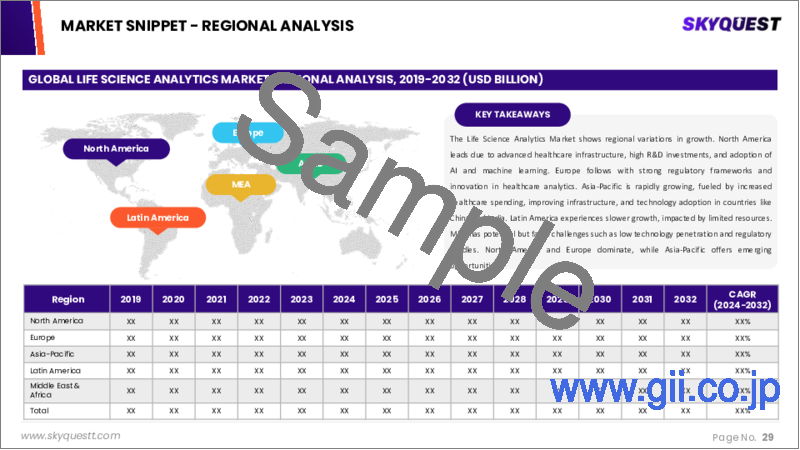|
|
市場調査レポート
商品コード
1527845
ライフサイエンス分析の市場規模、シェア、成長分析:コンポーネント別、タイプ別、地域別 - 産業予測、2024年~2031年Life Science Analytics Market Size, Share, Growth Analysis, By Component(Software, and Services), By Type(Reporting, Descriptive, Predictive, and Prescriptive), By Region - Industry Forecast 2024-2031 |
||||||
|
|||||||
| ライフサイエンス分析の市場規模、シェア、成長分析:コンポーネント別、タイプ別、地域別 - 産業予測、2024年~2031年 |
|
出版日: 2024年07月22日
発行: SkyQuest
ページ情報: 英文 157 Pages
納期: 3~5営業日
|
- 全表示
- 概要
- 目次
世界のライフサイエンス分析の市場規模は、2022年に268億米ドルとなり、予測期間(2024年~2031年)のCAGRは11.4%で、2023年の298億6,000万米ドルから、2031年までには701億米ドルに成長する見通しです。
ライフサイエンス分析市場は、ヘルスケアデータの急激な増加とデータ主導の洞察に対するニーズの高まりに後押しされて急成長を遂げています。電子カルテ、ゲノムデータ、実世界のエビデンスなど、さまざまなデータソースが融合することで、分析アプリケーションのための豊かなエコシステムが構築されています。人工知能や機械学習などの先進技術を活用することで、ライフサイエンス企業は貴重な洞察を引き出し、創薬の加速化、臨床試験の最適化、患者の転帰の改善を図ることができます。データプライバシー、統合、人材獲得に関する課題は依然として残っているものの、ヘルスケア業界におけるデータ主導の意思決定とイノベーションに対する需要の高まりに後押しされ、ライフサイエンス分析の全体的な市場見通しは引き続き明るいです。
目次
イントロダクション
- 調査の目的
- 定義
- 市場範囲
調査手法
- 情報調達
- 二次・一次情報源
- 市場規模予測
- 市場の前提条件と制限
エグゼクティブサマリー
- 市場概要見通し
- 供給需要動向分析
- セグメント別機会分析
市場力学と見通し
- 市場力学
- 促進要因
- 機会
- 抑制要因
- 課題
- ポーターの分析
主要な市場の考察
- 市場の主要な成功要因
- 競合の程度
- 主要な投資機会
- 市場魅力度指数
- エコシステムマッピング
- 技術分析
- サプライチェーン分析
- バリューチェーン分析
- 運用分析
- 特許分析
- 貿易分析
- 価格分析
- 使用事例分析
- スタートアップ分析
- パイプライン分析
ライフサイエンス分析市場:タイプ別
- 市場概要
- 概要的
- 予測的
- 規範的
ライフサイエンス分析市場:コンポーネント別
- 市場概要
- ソフトウェア
- サービス
ライフサイエンス分析市場:配信別
- 市場概要
- オンプレミス配信モデル
- オンデマンド配信モデル
ライフサイエンス分析市場:用途別
- 市場概要
- 研究開発
- 臨床試験
- 前臨床試験
- セールス・マーケティング
- 医薬品安全性監視
- 規制コンプライアンス
- サプライチェーンの最適化
ライフサイエンス分析市場:エンドユーザー別
- 市場概要
- 製薬・バイオテクノロジー企業
- 医療機器企業
- 研究センター
- サードパーティの管理者
ライフサイエンス分析市場規模:地域別
- 市場概要
- 北米
- 米国
- カナダ
- 欧州
- ドイツ
- 英国
- フランス
- イタリア
- スペイン
- その他欧州地域
- アジア太平洋
- 中国
- インド
- 日本
- 韓国
- その他アジア太平洋
- ラテンアメリカ
- ブラジル
- その他ラテンアメリカ地域
- 中東・アフリカ(MEA)
- GCC諸国
- 南アフリカ
- その他中東・アフリカ地域
競合情勢
- 上位5社の比較
- 主要企業の市場ポジショニング(2023年)
- 主要な市場企業が採用した戦略
- 市場における最近の活動
- 主要企業の市場シェア(2023年)
主要企業プロファイル
- ORACLE(US)
- IBM(US)
- SAS INSTITUTE INC.(US)
- ACCENTURE(Ireland)
- IQVIA INC.(US)
- COGNIZANT(US)
- WIPRO(India)
- ALLSCRIPTS HEALTHCARE, LLC(US)
- OPTUM, INC.(US)
- MICROSOFT(US)
- MAXISIT(US)
- EXLSERVICE HOLDINGS, INC.(US)
- CERNER CORPORATION(US)
- CITIUSTECH INC.(US)
- SAAMA TECHNOLOGIES, LLC(US)
- AXTRIA(US)
- CLARIVATE(UK)
- THOUGHTSPHERE(US)
- ALTERYX, INC.(US)
- SISENSE INC.(US)
- AMAZON WEB SERVICES, INC.(US)
- VEEVA SYSTEMS(US)
Global Life Science Analytics Market size was valued at USD 26.80 Billion in 2022 and is poised to grow from USD 29.86 Billion in 2023 to USD 70.10 Billion by 2031, at a CAGR of 11.4 % during the forecast period (2024-2031).
The life science analytics market is experiencing rapid growth fueled by the exponential increase in healthcare data and the growing need for data-driven insights. The convergence of various data sources, including electronic health records, genomic data, and real-world evidence, has created a rich ecosystem for analytics applications. By leveraging advanced technologies such as artificial intelligence and machine learning, life sciences organizations can extract valuable insights to accelerate drug discovery, optimize clinical trials, and improve patient outcomes. While challenges related to data privacy, integration, and talent acquisition persist, the overall market outlook for life science analytics remains positive, driven by the increasing demand for data-driven decision-making and innovation in the healthcare industry.
Top-down and bottom-up approaches were used to estimate and validate the size of the Global Life Science Analytics Market and to estimate the size of various other dependent submarkets. The research methodology used to estimate the market size includes the following details: The key players in the market were identified through secondary research, and their market shares in the respective regions were determined through primary and secondary research. This entire procedure includes the study of the annual and financial reports of the top market players and extensive interviews for key insights from industry leaders such as CEOs, VPs, directors, and marketing executives. All percentage shares split, and breakdowns were determined using secondary sources and verified through Primary sources. All possible parameters that affect the markets covered in this research study have been accounted for, viewed in extensive detail, verified through primary research, and analyzed to get the final quantitative and qualitative data.
Global Life Science Analytics Market Segmental Analysis
The global life science analytics market is segmented on the basis of type, component, delivery, application, end-user and region. Based on type, the market is segmented into descriptive, predictive, and prescriptive. Based on component, the market is segmented into software, and services. In terms of delivery, the market is segmented into on-premise model, and on-demand model. By application, the market is segmented into research & development, preclinical trials, clinical trials, sales & marketing, regulatory compliance, supply chain optimization, pharmacovigilance. By end-user, the market is segmented into pharmaceutical & biotechnology companies, medical device companies, research centers, and third-party administrators. By region, the market is segmented into North America, Europe, Asia Pacific, Middle East and Africa, and Latin America.
Drivers of the Global Life Science Analytics Market
The growing utilization of real-world data (RWD) is revolutionizing the life sciences industry. By harnessing the power of electronic health records, wearables, and other data sources, organizations can gain valuable insights into patient populations, disease progression, and treatment effectiveness. RWD enables the development of more targeted therapies, accelerates drug development timelines, and supports evidence-based decision-making. As the volume and complexity of RWD continue to expand, advanced analytics and data management capabilities will be essential for unlocking its full potential.
Restraints in the Global Life Science Analytics Market
Data privacy and security are critical challenges in the life science analytics market. The handling of sensitive patient data requires stringent measures to protect information from unauthorized access, breaches, and misuse. Compliance with regulations like GDPR and HIPAA is essential to maintain patient trust and avoid legal repercussions. Organizations must invest in robust security infrastructure, implement data encryption and access controls, and adhere to strict data governance practices. Additionally, ensuring data quality and integrity is crucial for deriving accurate and reliable insights. By addressing these challenges, life science organizations can build trust with patients and stakeholders while maximizing the value of their data assets.
Market Trends of the Global Life Science Analytics Market
The demand for real-time analytics is rapidly increasing as organizations seek to gain a competitive edge and make data-driven decisions at the speed of business. By processing and analyzing data as it is generated, businesses can identify trends, patterns, and anomalies instantaneously, enabling timely interventions and optimized operations. This shift towards real-time insights is being driven by factors such as the increasing volume and velocity of data, the rise of IoT devices, and the need for rapid response to market changes. As technology continues to advance, real-time analytics is expected to become a critical capability for organizations across industries.
Table of Contents
Introduction
- Objectives of the Study
- Definitions
- Market Scope
Research Methodology
- Information Procurement
- Secondary & Primary Data Sources
- Market Size Estimation
- Market Assumptions & Limitations
Executive Summary
- Market Overview Outlook
- Supply Demand Trend Analysis
- Segmental Opportunity Analysis
Market Dynamics & Outlook
- Market Dynamics
- Drivers
- Opportunities
- Restraints
- Challenges
- Porters Analysis
- Competitive rivalry
- Threat of Substitute Products
- Bargaining Power of Buyers
- Threat of New Entrants
- Bargaining Power of Suppliers
Key Market Insights
- Key Success Factors of The Market
- Degree Of Competition
- Top Investment Pockets
- Market Attractive Index
- Ecosystem Mapping
- Technology Analysis
- Supply Chain Analysis
- Value Chain Analysis
- Operational Analysis
- Patent Analysis
- Trade Analysis
- Pricing Analysis
- Use Case Analysis
- Startup Analysis
- Pipeline Analysis
Life Science Analytics Market by Type
- Market Overview
- Descriptive
- Predictive
- Prescriptive
Life Science Analytics Market by Component
- Market Overview
- Software
- Services
Life Science Analytics Market by Delivery
- Market Overview
- On-Premise Delivery Model
- On-Demand Delivery Model
Life Science Analytics Market by Application
- Market Overview
- Research & Development
- Clinical Trials
- Preclinical Trials
- Sales & Marketing
- Pharmacovigilance
- Regulatory Compliance
- Supply Chain Optimization
Life Science Analytics Market by End-User
- Market Overview
- Pharmaceutical & Biotechnology Companies
- Medical Device Companies
- Research Centers
- Third-party Administrators
Life Science Analytics Market Size by Region
- Market Overview
- North America
- USA
- Canada
- Europe
- Germany
- UK
- France
- Italy
- Spain
- Rest of Europe
- Asia Pacific
- China
- India
- Japan
- South Korea
- Rest of Asia-Pacific
- Latin America
- Brazil
- Rest of Latin America
- Middle East & Africa (MEA)
- GCC Countries
- South Africa
- Rest of MEA
Competitive Landscape
- Top 5 Player Comparison
- Market Positioning of Key Players, 2023
- Strategies Adopted by Key Market Players
- Recent Activities in the Market
- Key Companies Market Share (%), 2023
Key Company Profiles
- ORACLE (US)
- Company Overview
- Business Segment Overview
- Financial Updates
- Key Developments
- IBM (US)
- Company Overview
- Business Segment Overview
- Financial Updates
- Key Developments
- SAS INSTITUTE INC. (US)
- Company Overview
- Business Segment Overview
- Financial Updates
- Key Developments
- ACCENTURE (Ireland)
- Company Overview
- Business Segment Overview
- Financial Updates
- Key Developments
- IQVIA INC. (US)
- Company Overview
- Business Segment Overview
- Financial Updates
- Key Developments
- COGNIZANT (US)
- Company Overview
- Business Segment Overview
- Financial Updates
- Key Developments
- WIPRO (India)
- Company Overview
- Business Segment Overview
- Financial Updates
- Key Developments
- ALLSCRIPTS HEALTHCARE, LLC (US)
- Company Overview
- Business Segment Overview
- Financial Updates
- Key Developments
- OPTUM, INC. (US)
- Company Overview
- Business Segment Overview
- Financial Updates
- Key Developments
- MICROSOFT (US)
- Company Overview
- Business Segment Overview
- Financial Updates
- Key Developments
- MAXISIT (US)
- Company Overview
- Business Segment Overview
- Financial Updates
- Key Developments
- EXLSERVICE HOLDINGS, INC. (US)
- Company Overview
- Business Segment Overview
- Financial Updates
- Key Developments
- CERNER CORPORATION (US)
- Company Overview
- Business Segment Overview
- Financial Updates
- Key Developments
- CITIUSTECH INC. (US)
- Company Overview
- Business Segment Overview
- Financial Updates
- Key Developments
- SAAMA TECHNOLOGIES, LLC (US)
- Company Overview
- Business Segment Overview
- Financial Updates
- Key Developments
- AXTRIA (US)
- Company Overview
- Business Segment Overview
- Financial Updates
- Key Developments
- CLARIVATE (UK)
- Company Overview
- Business Segment Overview
- Financial Updates
- Key Developments
- THOUGHTSPHERE (US)
- Company Overview
- Business Segment Overview
- Financial Updates
- Key Developments
- ALTERYX, INC. (US)
- Company Overview
- Business Segment Overview
- Financial Updates
- Key Developments
- SISENSE INC. (US)
- Company Overview
- Business Segment Overview
- Financial Updates
- Key Developments
- AMAZON WEB SERVICES, INC. (US)
- Company Overview
- Business Segment Overview
- Financial Updates
- Key Developments
- VEEVA SYSTEMS (US)
- Company Overview
- Business Segment Overview
- Financial Updates
- Key Developments





